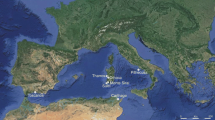Abstract
The archaeological site of “Le Grottelline”, in the territory of Spinazzola, province of Bari (southern Italy), which dates back to the Early Neolithic Age, is located in the Bradanic Trough. Abundant ceramic material was recovered, which mainly belongs to the Culture of “Archaic-Impressed Pottery” and appears similar to that found in other Neolithic sites of the Murge area. The archaeologists recognized four ceramic classes: coarse, semi-depurated, depurated, and figulina. Fine ceramics can be red paint decorated. Aim of this work was a preliminary archaeometric characterization of the ceramic material from “Le Grottelline” in order to have information about the use of local raw materials and to address subsequent studies aimed to verify the relationships among the Neolithic cultures of the Murge area. The present study evidenced two typologies of ceramic body, characterized by calcium-rich and calcium-poor pastes, respectively, and two single samples. For the two groups of ceramics, a manufacture with local raw materials is assumed by using two types of clay: carbonate clays from “Subapennine Clays” formation and residual carbonate-free clays such as the well-known “red earths”. These two ceramic typologies are very similar to those reported for the near Neolithic site of Ciccotto, and it also located in the Bradanic Trough. For the two single samples, on the contrary, a manufacturing with “Alluvial Clays” and a provenance from the site of Pulo di Molfetta are supposed. The red painted decorations are aluminum- and iron-rich, while the content of calcium can be very different.





Similar content being viewed by others
References
Casnedi R (1988) La Fossa Bradanica: origine, sedimentazione e migrazione. Mem Soc Geol It 41:439–488
Cultrone G, Rodriguez-Navarro C, Sebastian E, Cazalla O, De La Torre MJ (2001) Carbonate and silicate phase reactions during ceramic firing. Eur J Mineral 13:621–634
Dell’Anna L (1967) Ricerche su alcune “terre rosse” della Regione Pugliese. Periodico di Mineralogia 38:515–577
Dell’Anna L, Garavelli CL (1968) Su alcune “terre rosse” della Puglia settentrionale. Grafiche Rossi, Bari
Dell’Anna L, Laviano R (1991) Mineralogical and chemical classification of Pleistocene clays from the Lucanian Basin (southern Italy) for the use in the Italian tile industry. Appl Clay Sci 6:233–243
Dondi M, Fabbri B, Laviano R (1992) Characteristics of the clays utilized in the brick industry in Apulia and Basilicata (southern Italy). Miner Petrogr Acta XXXV:181–191
Fabbri B (1998) The problem of defining the firing temperature of ceramic artifacts. Proceedings XIII U.I.S.P.P., Forlì, September 1996, Vol 1, pp 207–214
Fabbri B, Gualtieri S (2008) Alterazione post-deposizionale di ceramiche neolitiche con formazione di macropori e arricchimento di fosforo. Rendiconti online Soc Geol It 2:361–362
Laviano R, Moresi M (2008) Le materie prime per la produzione della ceramica: le Argille di Rutigliano. Atti del Seminario di Studi “Ceramica e Archeometria in Puglia”, 22 January 2005, Rutigliano (BA), Ed. L’Artigiangrafica Guarnieri (Rutigliano—BA), pp 17–25
Laviano R, Muntoni IM (2003a) Ciccotto: analisi archeometriche. In: Muntoni IM (ed) Modellare l’argilla. Vasai del Neolitico antico e medio nelle Murge pugliesi. Istituto Italiano di Preistoria e Protostoria, Firenze, pp 276–286
Laviano R, Muntoni IM (2003b) Pulo di Molfetta: analisi archeometriche. In: Muntoni IM (ed) Modellare l’argilla. Vasai del Neolitico antico e medio nelle Murge pugliesi. Istituto Italiano di Preistoria e Protostoria, Firenze, pp 143–159
Laviano R, Muntoni IM (2006) Provenance and technology of Apulian Neolithic pottery. In: Maggetti M, Messiga B (eds) Geomaterials in cultural heritage. Special publication, 257. Geological Society, London, pp 49–62
Lazzari M, Pieri P (2002) Modello stratigrafico-deposizionale della successione regressiva infrapleistocenica della Fossa Bradanica nell’area compresa tra Lavello, Genzano e Spinazzola. Mem Soc Geol It 41:121–140
Lorenzi R, Serradimigni M (2009) Il sito neolitico de Le Grottelline (Spinazzola, Bari). Origini XXXI, Nuova Serie IV:41–74
Maritan L, Mazzoli C (2004) Phosphate in archaeological finds: implications for environmental conditions of burial. Archaeometry 46(4):673–683
Mongelli G (1994) Le bauxiti carsiche apule: composizione chimica e modello genetico. Plinius 12:72–74
Morelli F, Cullers R, Laviano R, Mongelli G (2000) Geochemistry and palaeoenvironmental significance of Upper Cretaceous clay-rich beds from the Peri-Adriatic Apulia carbonate Platform, southern Italy. Per Mineral 69(2):165–183
Muntoni IM (2003) Modellare l’argilla. Vasai del Neolitico antico e medio nelle Murge pugliesi. Istituto Italiano di Preistoria e Protostoria, Firenze
Riccardi MP, Messiga B, Duminuco P (1999) An approach to the dynamics of clay firing. Appl Clay Sci 15:393–409
Ricciardi P, Nodari L, Fabbri B, Gualtieri S, Russo U (2007) Contribution for a mineralogical thermometer to be applied to low fired and/or non-carbonate ceramics. In: Proceedings 8th EMAC, Lyon 2005, BAR International Series 1691, pp 13–18
Trindade MJ, Dias MI, Coroado J, Rocha F (2009) Mineralogical transformation of calcareous rich clays with firing: a comparative study between calcite and dolomite rich clays from Algarve, Portugal. Appl Clay Sci 42:345–355
Author information
Authors and Affiliations
Corresponding author
Rights and permissions
About this article
Cite this article
Fabbri, B., Gualtieri, S. & Lorenzi, R. Preliminary archaeometric study of the Neolithic pottery from the “Le Grottelline” site (Spinazzola, Italy). Archaeol Anthropol Sci 5, 235–243 (2013). https://doi.org/10.1007/s12520-013-0132-9
Received:
Accepted:
Published:
Issue Date:
DOI: https://doi.org/10.1007/s12520-013-0132-9




